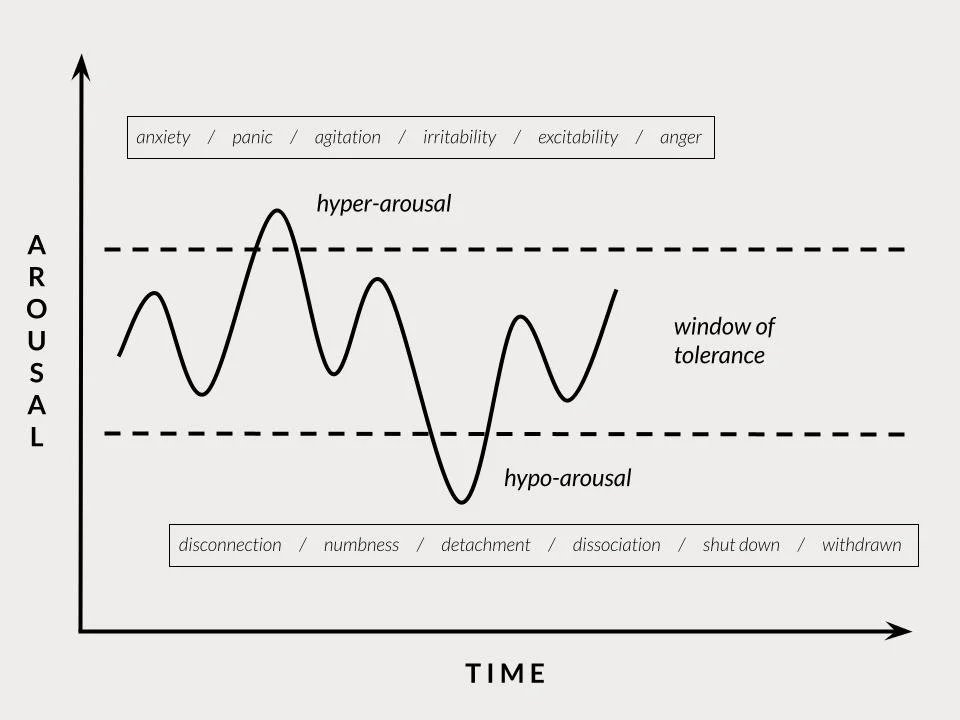What Is the Window of Tolerance and Why Is It Important?
Do you find that it doesn’t take a whole lot to push you over the edge? Maybe you’ve noticed that a small comment or a minor inconvenience sends you into a fit of anger or turns you into a ball of anxiety. Or perhaps you find yourself completely shutting down or withdrawing when faced with similarly distressing situations. Do you ever wonder what’s going on internally to cause these sorts of reactions? If so, it may be helpful to learn about something called the window of tolerance.
For those who have never participated in any form of mental health therapy, the concept of the window of tolerance may be unfamiliar. Basically, it is the zone in which we are able to function appropriately and be the best, most grounded and connected version of ourselves. Think of it like Goldilocks—you’re not feeling too much, you’re not feeling too little, you’re feeling just the right amount. When we are outside of our window of tolerance, we are either in a state of hyper-arousal or hypo-arousal. Sometimes we’ll find ourselves above our window in a state of hyper-arousal, which is characterized by intense anxiety, panic, agitation, irritability, and over-excitability. Other times we might be below our window in a state of hypo-arousal, where we can feel disconnected, numb, detached, and dissociated.
illustration of the window of tolerance
Every individual has a different window of tolerance. The size of one’s window of tolerance is determined by a variety of factors, including early childhood experiences, how emotion regulation has been modeled by peers and adults, instances of trauma or intense distress, and the characteristics of one’s environment. For some, it might be a rare occasion that they wander outside of their window into a state of hyper- or hypo-arousal. Most of the time they feel emotionally well-regulated and even-keeled. That doesn’t mean that they never become dysregulated, but their window of tolerance is usually wide enough that it takes a significant stressor to push them outside of it. For others, like the ones described above, it doesn’t take quite as much to push them outside of their window. They might be easily irritable, quick to shut down when faced with conflict, or frequently overwhelmed with the stressors of life.
Both of these groups can benefit from knowing the boundaries of their window of tolerance and the factors that can push them outside of their window. Knowing these two things can help you prepare for stress, anticipate how you might respond to it, and take the appropriate actions to help yourself better regulate. However, if you identify with the latter group, it could be especially helpful to focus on gradually and intentionally expanding your window of tolerance. This can be done by learning and practicing a variety of different techniques, including mindfulness, distress tolerance, and emotion regulation skills.
Expanding your window of tolerance is not a quick and easy process. It takes intentional effort and consistent practice. Just like when stengthening a muscle, the goal is not to push past your limit to the point of being flooded or overwhelmed. Your window will only develop and grow if you stretch your capacity for tolerating distress and then take time to rest and regroup before testing your capacity once again. This is why it can be beneficial to work with a licensed and trained mental health therapist who can collaborate with you to develop a plan that prioritizes both your personal growth and wellbeing. If you’d like to learn more about your own window of tolerance and how to expand it, I would encourage you to reach out to a therapist in your area for a consultation.

